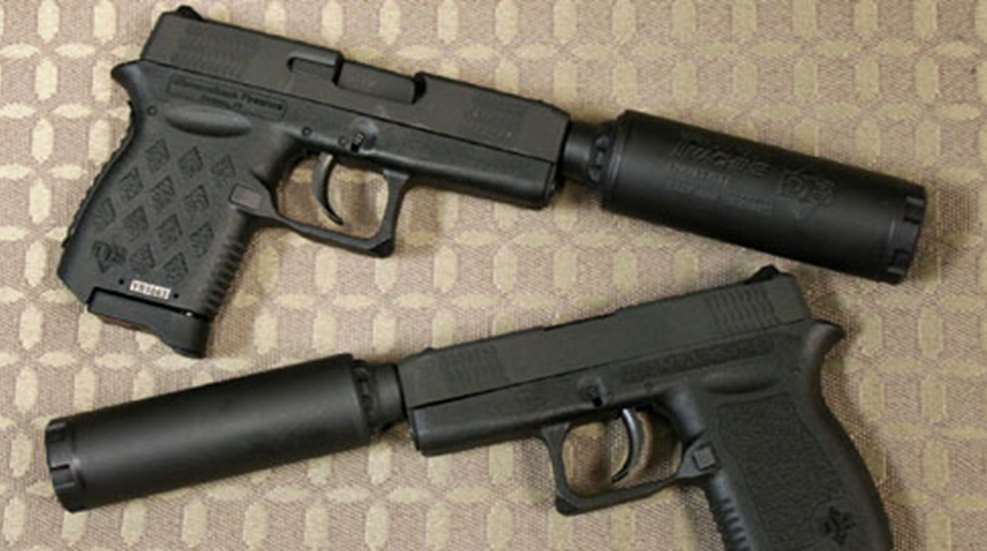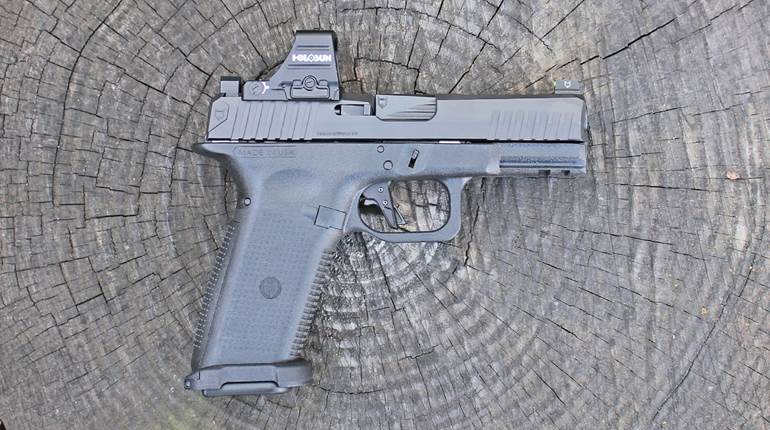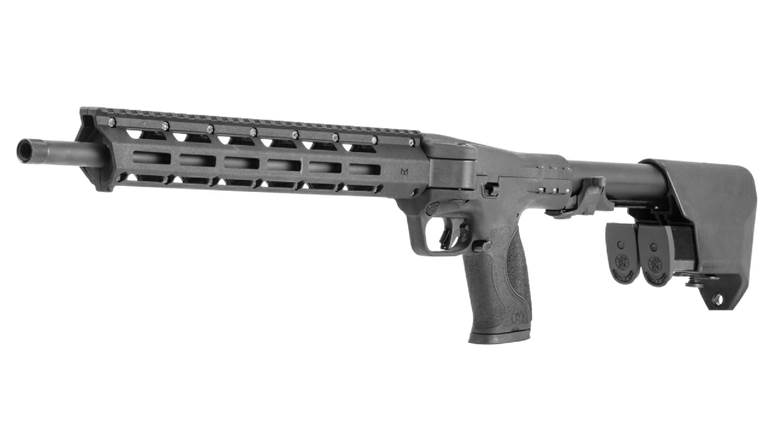
For 2012, Diamondback has introduced new proprietary suppressor and threaded barrel kits for use with the new and existing DB380 and DB9 pistols. Diamondback is touting its pocket autos, with the suppressors attached, as the smallest and lightest suppressed pistols currently available. While visiting the NASGW Show in November, I had the opportunity to handle both the .380 ACP and 9 mm suppressed prototypes.
The suppressed DB380 has an overall length of 9.27 inches and an unloaded weight of just 11.50 ounces. The slightly larger DB9 pistol, which uses a marginally larger suppressor, tips the scales at 14.7 ounces and has an overall length of 9.72 inches. Just for comparison, an all-steel 5-inch barrel 1911 .45 ACP pistol has an overall length of 8.50 inches with an unloaded weight of 40 ounces. Diamondback's system is light and compact indeed. Since I was already familiar with the standard pistols, I couldn't wait to test drive them suppressed.
The DB Compact Dedicated Wet Suppressors
In order to equip the DB380 and DB9 pistols to speak more politely at the range, Diamondback teamed up with Thompson Machine. While most full-size sound suppressors are relatively large, Thompson provides several small, unique “wet” suppressors for special purposes and applications. The result of this collaboration is a pair of compact, lightweight suppressors that comfortably fit the diminutive Diamondback handguns.
It's important to be aware that hollow-point ammunition should not be used when the Diamondback suppressors are attached to the DB380 or DB9 pistols. Only full-metal jacket (FMJ) or total-metal jacket (TMJ) rounds should be fired. Two good reasons for this are worth noting. First, the cutting edge of hollow points will chop a hole in the wipe. This turns a multi-shot wipe into a single-shot wipe. The second, and more important, reason for avoiding hollow points is that Thomson Machine's laboratory tests show evidence of hollow points starting to expand and change their flight path while the bullet is still inside the suppressor.
For the DB380, most standard pressure FMJ .380 ACP cartridges arrive from the factory loaded to travel at subsonic speeds. Since the shorter barrel of the DB380 reduces the velocity a bit more, you're ready to get to work. For the DB9, the wide variety of 9 mm loads to choose from need to be narrowed down to those suited for this pistol and suppressor combination. +P and +P+ loads produce too much pressure and velocity for this system and should be avoided completely. 9 mm cartridges loaded with 147-grain bullets tend to be too long to feed reliably in the DB9's compact magazine and chamber. Lightweight bullets, 100 grains or less, generally fail to cycle the action. So what does that leave you with for the suppressed DB9? Standard pressure FMJ loads in the 115- to 124-grain range, which also happens to be the most common type of 9mm ammunition on the market.
Shooting DB Suppressors
A shooting session with the Diamondback suppressors involves a few more steps than running an unsuppressed handgun. Testing began with the removal of the standard barrels from a DB380 and DB9 pistol and the installation of the threaded barrels supplied with the suppressors. Each pistol was test fired without the suppressors attached to ensure everything was running smoothly, which it was.
The Diamondback suppressors arrived fully assembled and ready to fire, but bone dry. Shooters have tried a variety of liquids in wet suppressors, such as gun grease and silicon wire pulling gel. Knowing that these small suppressors would require regular re-wetting no matter what liquid I used, I opted for the most effective sound dampening liquid available, which also happens to be the most inexpensive and easy to clean up: ordinary tap water.
When it was time to test a suppressor, a small amount of water was poured into it though the base cap, rolled around to wet the interior of the tube and the mono-core baffle, and then the excess water was shaken out into a small container. Although some shooters choose to score or cut a small X into the center of newly installed wipes, the wipe material provided by Thompson Machine is elastic enough that no alterations are required. Once the suppressor was ready, it was threaded onto the unloaded pistol. With the suppressed pistol pointed down range, it was loaded and fired until the suppressor needed to be re-wetted or the wipe wore out.
How do you know it's time to re-wet the suppressor or change out the wipe? The best way to find out is through experimentation on the range. When the shots start getting louder, it's time to service the suppressor. For the DB380, the suppressor needed to be re-wetted after 10 to 12 rounds, and the wipes needed replacing after about 20 to 24 rounds.
The standard pressure 9 mm loads fired from the DB9 used up the suppressor's resources much more quickly. The suppressor needed to be re-wetted after each six-round magazine was fired, and the wipes were ready to trade out after 10 to 15 shots. While the DB380 warmed up during shooting, the DB9 suppressor became hot to the touch. It proved useful to have a rag to wrap this suppressor with to remove and hold it until it was cooled by the water poured into it.
DB Suppressor Performance
The DB380 benefited the most from the addition of the suppressor. The moderate recoil was measurably reduced to a modest push to the palm. The difference in the noise level between the suppressed and unsuppressed shots, with proper hearing protection in place, was obvious. When the range master notified me that I had the entire range to myself for a few minutes, I fired a few suppressed rounds with my hearing protection removed. The report of the suppressed .380 pistol was effectively reduced from an ear slapping crack, which I would not willingly expose my ears to, to a solid thump similar to the sound of a heavy book dropped onto a hard surface. Although the report was not reduced to the inaccurately portrayed "phut phut" sound you hear in movies, it was much more comfortable to work with.
The DB9, one of the most compact 9 mm pistols currently available, proved to be more energetic to work with. Loaded with standard pressure rounds, the unsuppressed DB9 produces nearly double the felt recoil of the unsuppressed DB380. However, the installation of the suppressor did effectively reduce felt recoil and drop the report of the pistol to a tolerable thump.
Although the range testing focused on the sound reduction, operability, and reliability of the Diamondback suppressor systems, it never hurts to take some time to verify accuracy. Formal accuracy testing was conducted using five-shot groups fired from a bench rest into targets set at 7 yards. The ammunition fired was relatively limited, since only certain FMJ and TMJ loads could be used.
The DB380 produced several 1.25-inch groups with both of the loads tested. The HPR 100-grain .380 ACP Hyperclean total metal jacket loads produced an average of 1.45 inches, followed by Winchester's USA Brand 95-grain .380 ACP full metal jacket loads with an average of 1.55 inches. The DB9, using Winchester USA brand 115-grain 9 mm FMJ USA Brand rounds produced a best single group of 1.75 inches, with a group average of 2.05 inches.
Final Thoughts
The new Diamondback suppressors for the DB380 and DB9 take these slick, reliable little pistols to a whole new level of shooting fun. Along with the super-cool 007 factor these new suppressors provide, the reduced recoil and noise levels make the pistols even more enjoyable to work with. Best of all, the price is right. You can buy a new Diamondback pistol along with the suppressor threaded barrel set for about the same price that a full-sized suppressor would cost on its own. I was once warned by a seasoned shooting buddy that I should just stay away from shooting sound-suppressed firearms. His reasoning was simple: Suppressors are addictive. He was spot-on in his assessment.
Manufacturer: Diamondback Firearms; diamondbackfirearms.com
Model: DB380
Action: “Zero-Energy” Striker Double-Action Only
DAO Trigger Pull: 5 lbs.
Caliber: .380 ACP
Slide Finish: Mil-Spec Manganese Phosphate, Nickel Boron (EX models), and Nickel
Sights: 3-Dot, Windage Adjustable Rear Sight
Barrel Length: 2.80”
Overall Length: 5.15”
Height: 3.75”
Width: 0.75”
Weight: 8.80 ozs., Unloaded
Capacity: 6+1 Rounds
Twist: 1:16” RH
Suggested Retail: $489.95
DB380 DB Sound Suppressor
Manufacturer: Thompson Machine
Type: Dedicated Wet Compact Suppressor
Material: 6061 T6 Anodized Aluminum
Length: 4.125”
Weight: 2.70 ozs.
Thread: Proprietary
Unit Price: $469.95 for Conversion Only (Barrel & Suppressor)
Model: DB9
Action: “Zero-Energy” Striker Double-Action Only
DAO Trigger Pull: 5 lbs.
Caliber: 9 mm
Slide Finish: Mil-Spec Manganese Phosphate, Nickel Boron (EX models), and Nickel
Sights: 3-Dot, Windage Adjustable Rear Sight
Barrel Length: 3”
Overall Length: 5.6”
Height: 4”
Width: 0.8”
Weight: 11 ozs., Unloaded
Capacity: 6+1 Rounds
Twist: 1:16” RH
Suggested Retail Price: $489.95
DB9 DB Sound Suppressor
Manufacturer: Thompson Machine
Type: Dedicated Wet Compact Suppressor
Material: 6061 T6 Anodized Aluminum
Length: 4.125”
Weight: 3.7 ozs.
Thread: Proprietary
Unit Price: $469.95 for Conversion Only (Barrel & Suppressor)





































